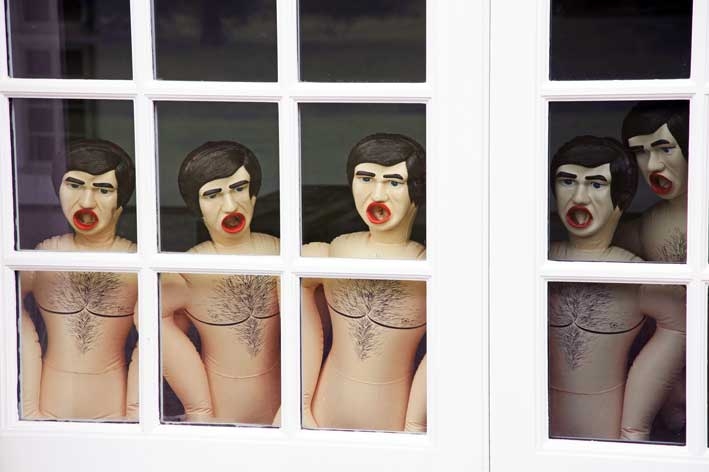Heavy beats thud through the Serpentine Gallery. Wallpaper featuring, Warhol-style, the repeated image of an owl – the words ‘stock image’ printed on each – cover the first gallery’s walls, surrounding a light sculpture – Gonzalez- Torres Untitled (America) (2004) – the ‘original’ of which was shown as part of Felix Gonzalez- Torres’s posthumous retrospective at the Serpentine in 2000. If I didn’t know any better, I would think I was in an exhibition of work by a hip, young ‘post-Internet’ (a term seemingly used to refer to anything vaguely digital) artist. Sturtevant, however, was born in 1930. The work on display in this exhibition dates back as far as the 1970s, but seeing the recent digital work, alongside earlier ‘repeats’, serves to emphasise the relationship between what she produced pre- and post-Internet.
For much of her career, she has remade or repeated other artists’ works: Joseph Beuys, Marcel Duchamp and Andy Warhol all ‘appear’ in this exhibition.
The brilliance of Sturtevant’s work lies in how she approaches ‘remaking’: she never refers to images of the ‘original’. Instead she creates from memory, performing the same processes as the artist – producing an end result that somehow channels the ‘aura’ of the original, rather than being a like-for-like copy. Moreover, she has always had an uncanny sixth sense for the zeitgeist: the artists she has repeated are all now considered canonical; yet when she repeated their works they were contemporaries who had not yet passed through the sieve of art history. Her first show of Warhol’s ‘piss’ flowers took place in 1965, only months after his.
At the Serpentine, the remakes are interspersed with more recent works such as the nine-channel video installations Elastic Tango (2012) and Blow Job (2006), both of which use a myriad of found still and moving imagery, forming pop-cultural commentaries (at points a parody of today’s digitised sexuality – the plasticity of a ‘porn aesthetic’, for example, is alluded to via closeups of glossy dolls’ asses). The relation- ship between Sturtevant’s earlier remakes and later digital work is emphasised in Pacman (2012): a remake of the ubiquitous computer game designed by Toro Iwatani in 1980. The original game was acquired by moma’s design department in 2012 and exhibited in 2013. Whether Sturtevant knew of this acquisition, I am unsure, but it’s a fact that epitomises the conceptual feedback loop inherent in her work: just as the ‘real’ game has been institu- tionalised, she remakes it as art. What differs here in respect to her early work is that rather than recreating Pac-Man at around the time of its creation, it was made 32 years later.
In a recent interview with The Huffington Post, Sturtevant stated, ‘Authenticity currently is nonexistent due to the imposition of cyber- netics.’ The term ‘cybernetics’ was formulated by the American mathematician Norbert Wiener during the 1940s to explore the feedback systems between animate and mechanical things. Cybernetics has gone through many incarnations since: today’s digital–human relationship forms an infinite network, one that British artist Mark Leckey (who shares Sturtevant’s interest in cybernetics in the digital age) has described as a prosthesislike ‘artificial God’ – in that the cyclical repetition of digital communication has become an extension of being human, one that is omnipresent and endlessly replicating itself. When discussing the cultural ramifications of this, Boris Groys recently wrote that ‘in the modern age, ritual, repetition, and reproduction have become the fate of the entire world, of the entire culture’. Yet perhaps the Internet has served to emphasise how ‘authenticity’, to some extent, has always been ‘performed’: in that stock images are used universally and the ‘self ’ is now publicly staged and broadcast. Perhaps what Sturtevant is getting at, via her entire body of work, is that ‘authenticity’ has never been a form of ‘truth’ or ‘reality’, but instead has been always subject to repetitious simulacra.
This review originally appeared in the October 2013 issue.
